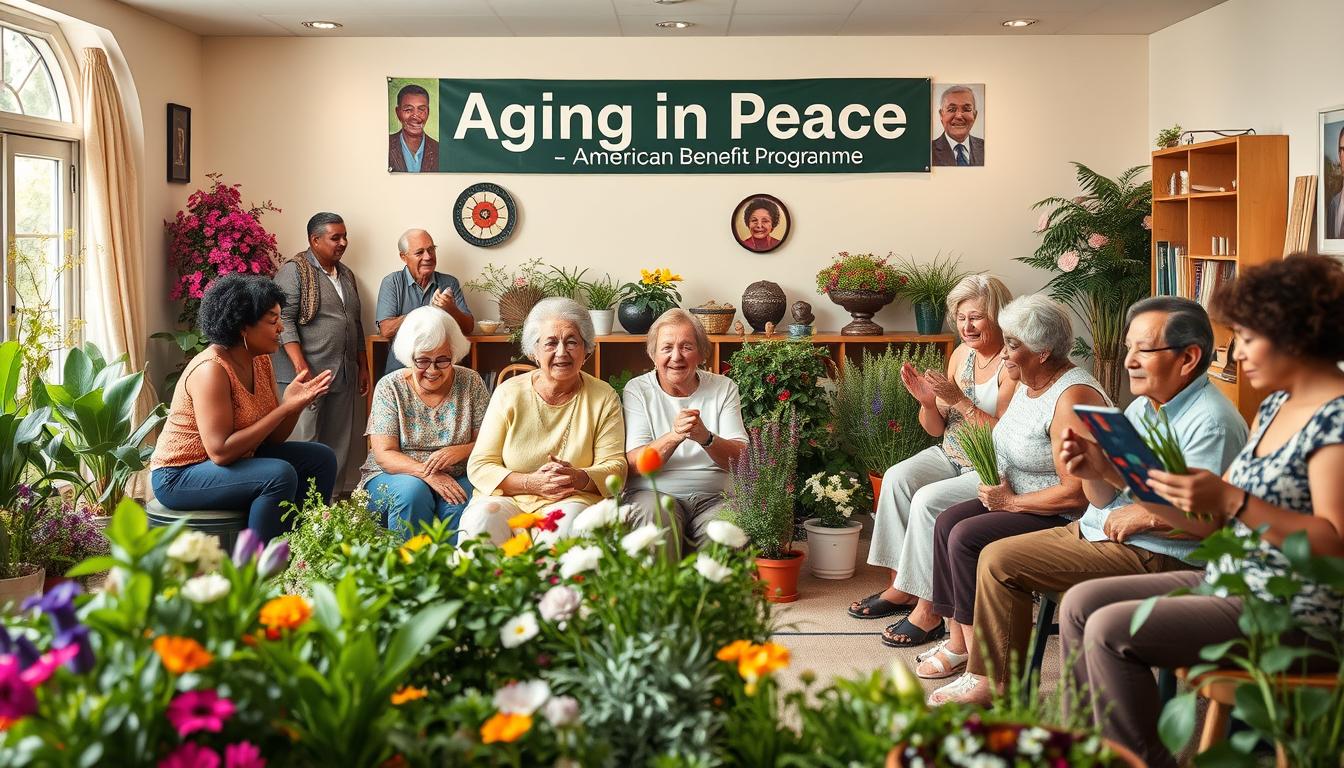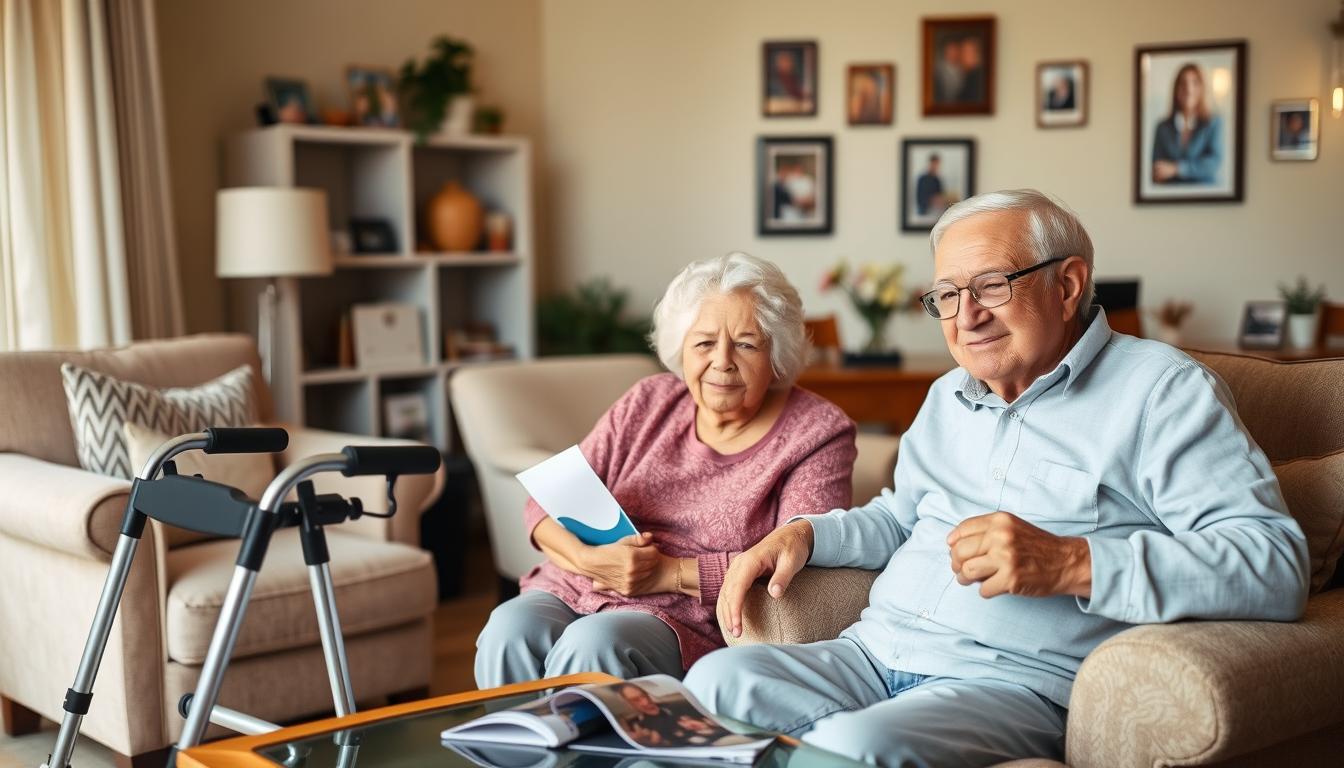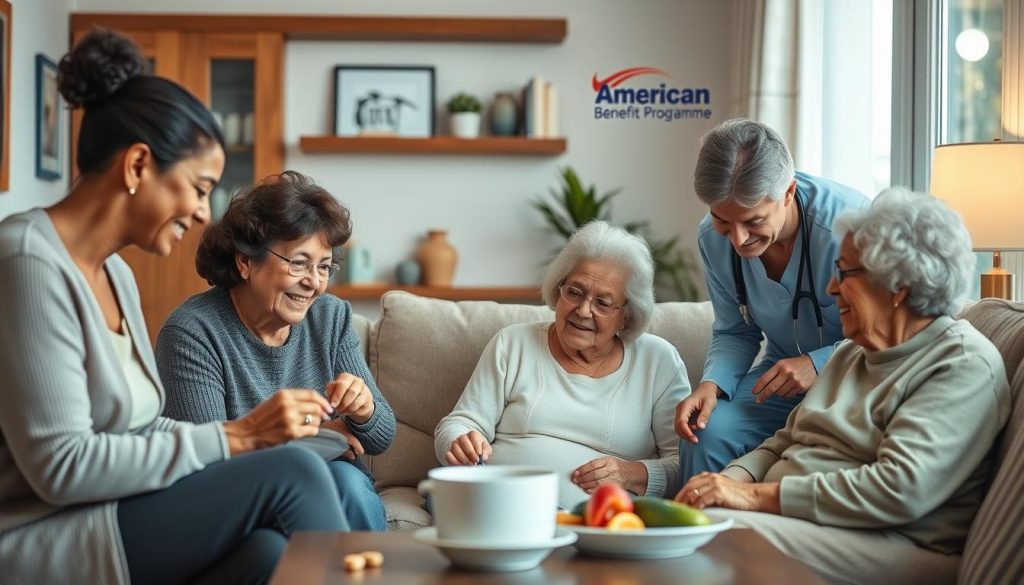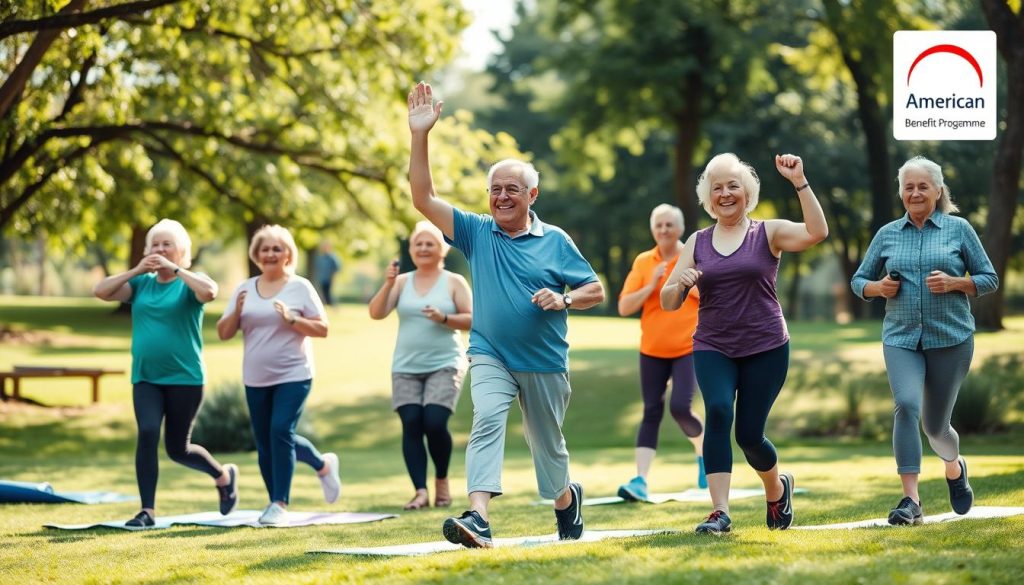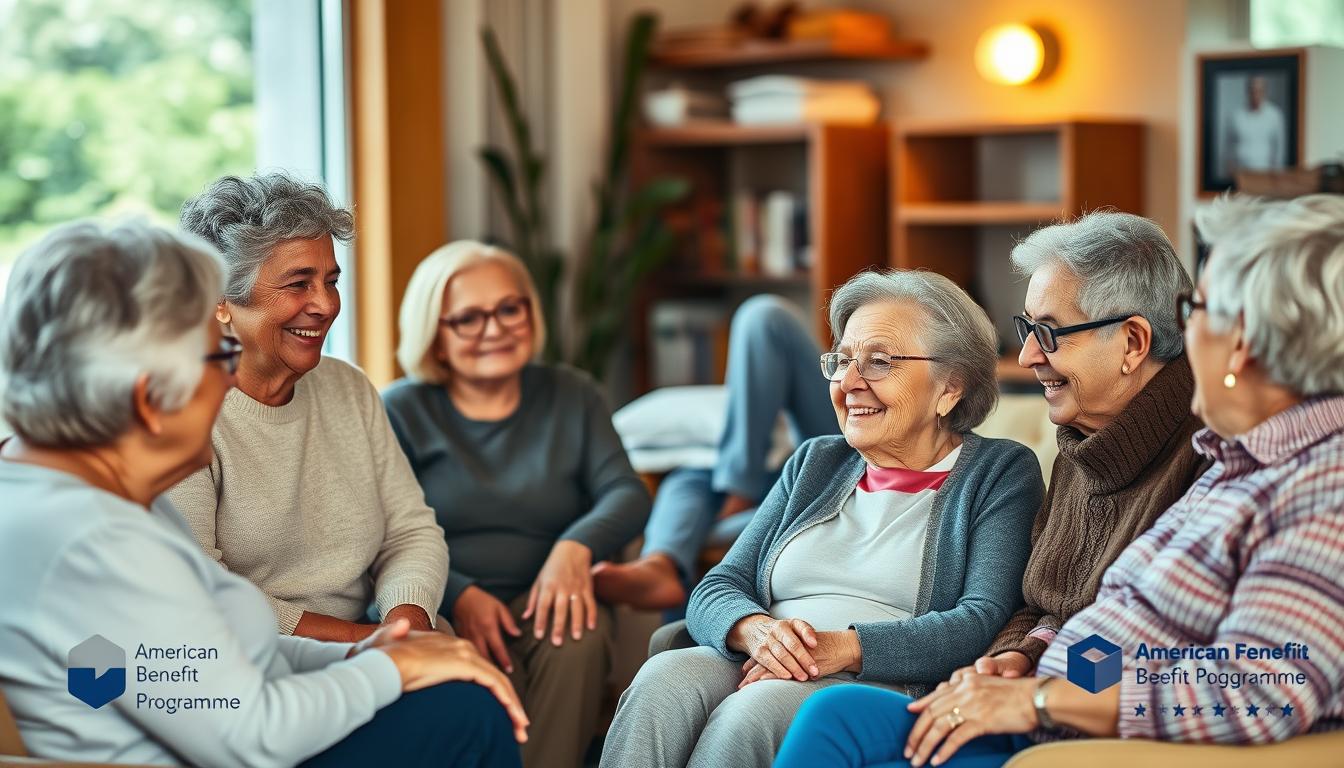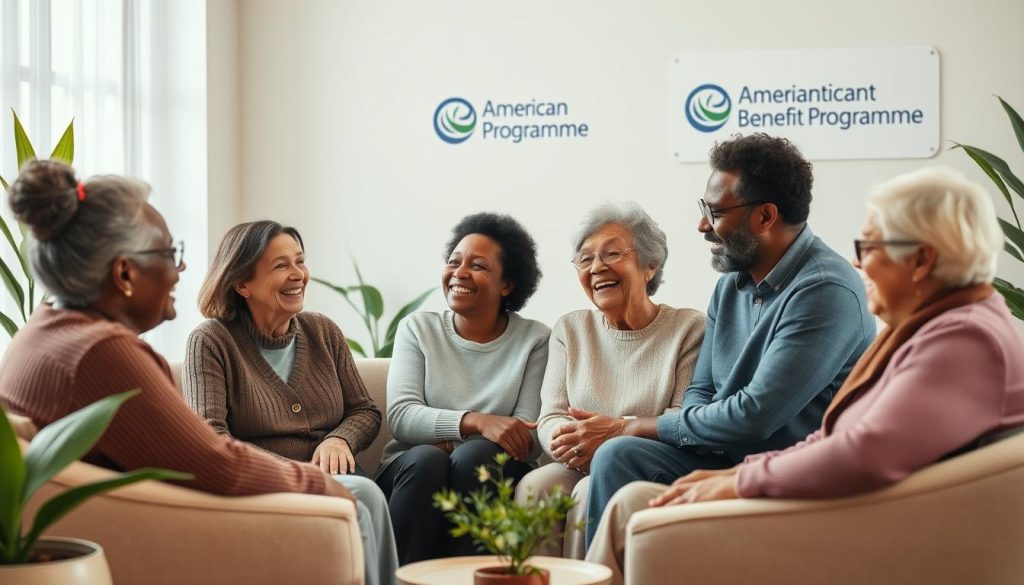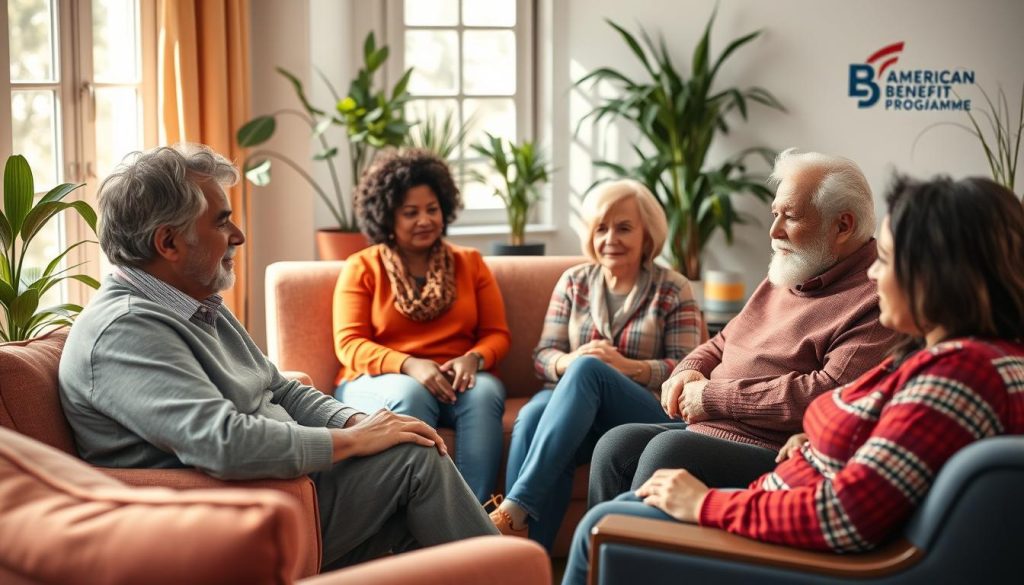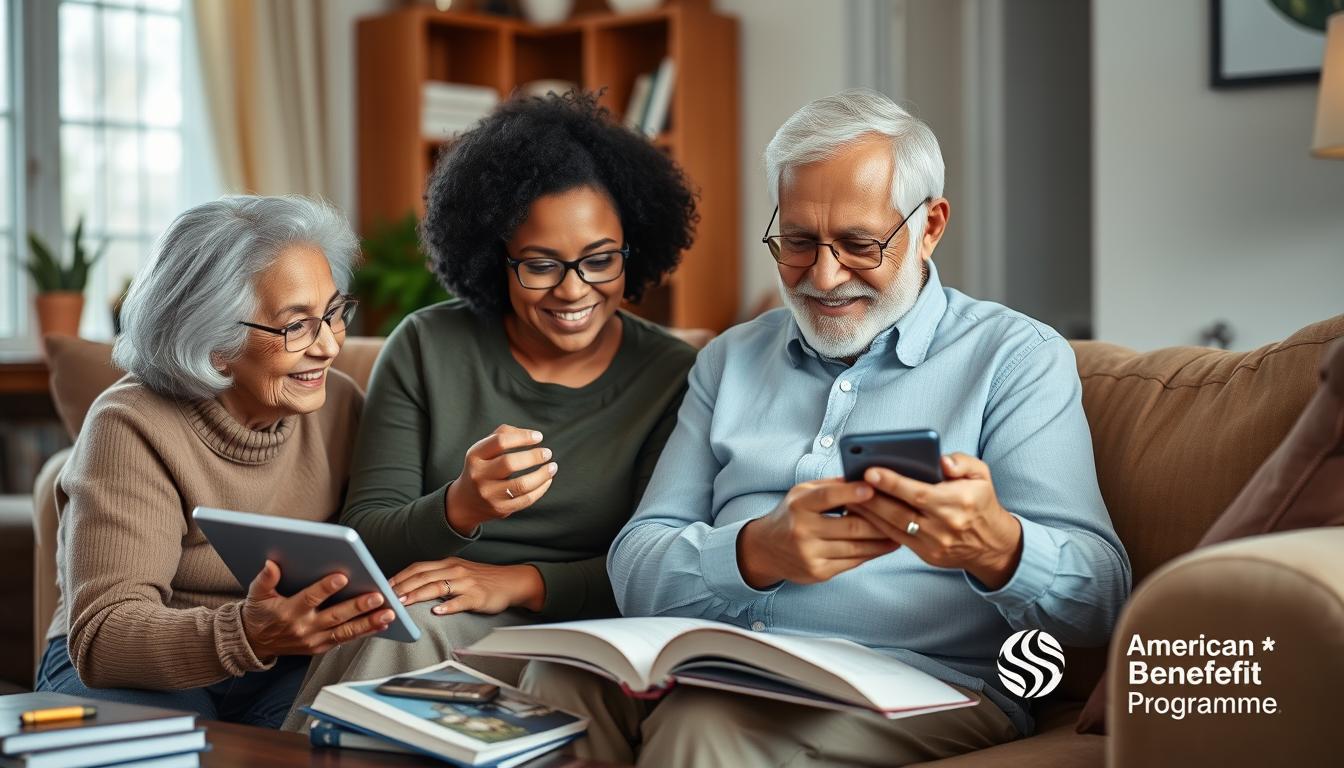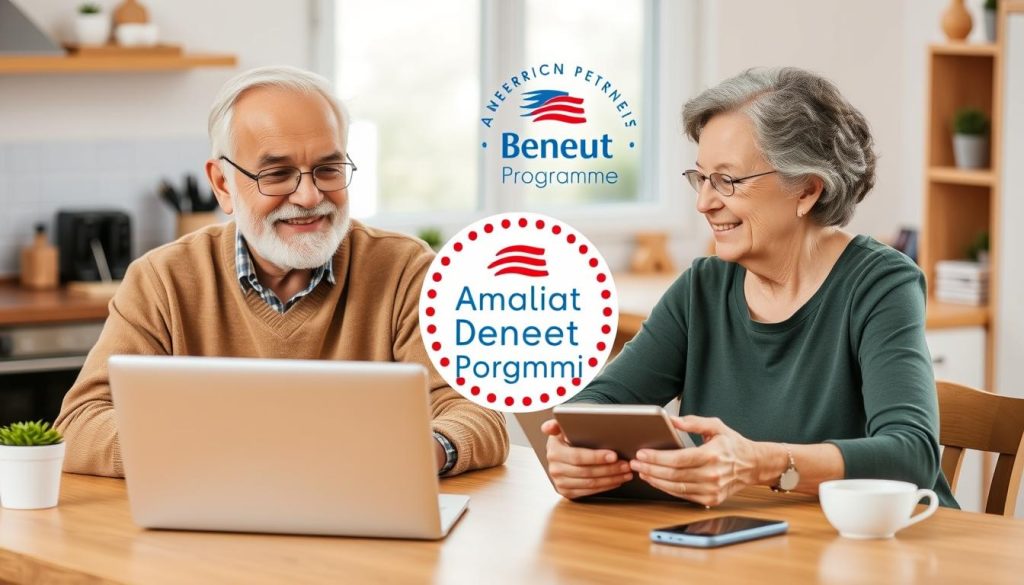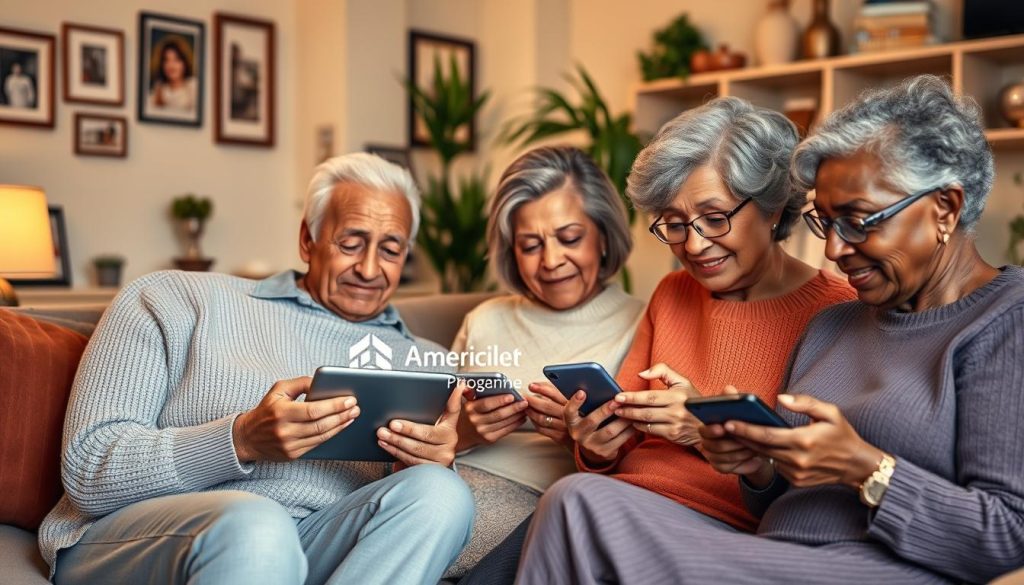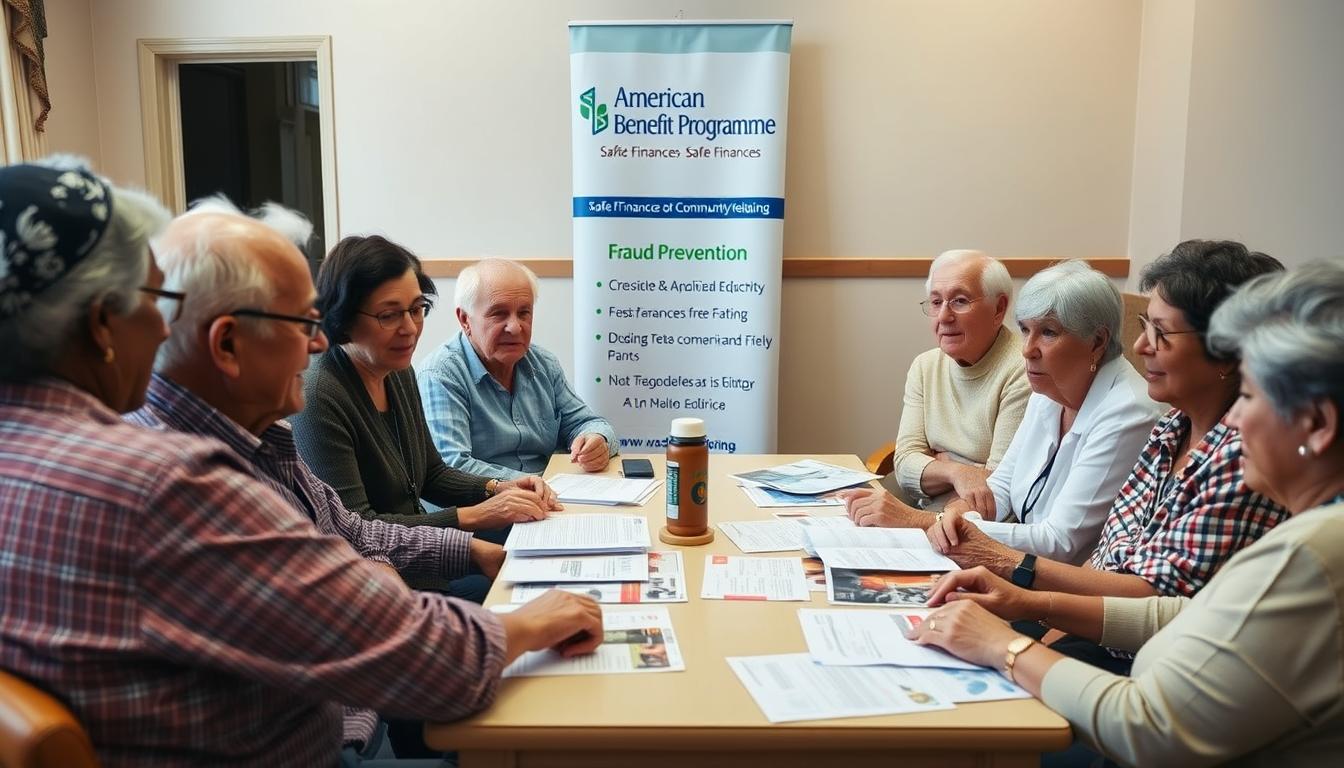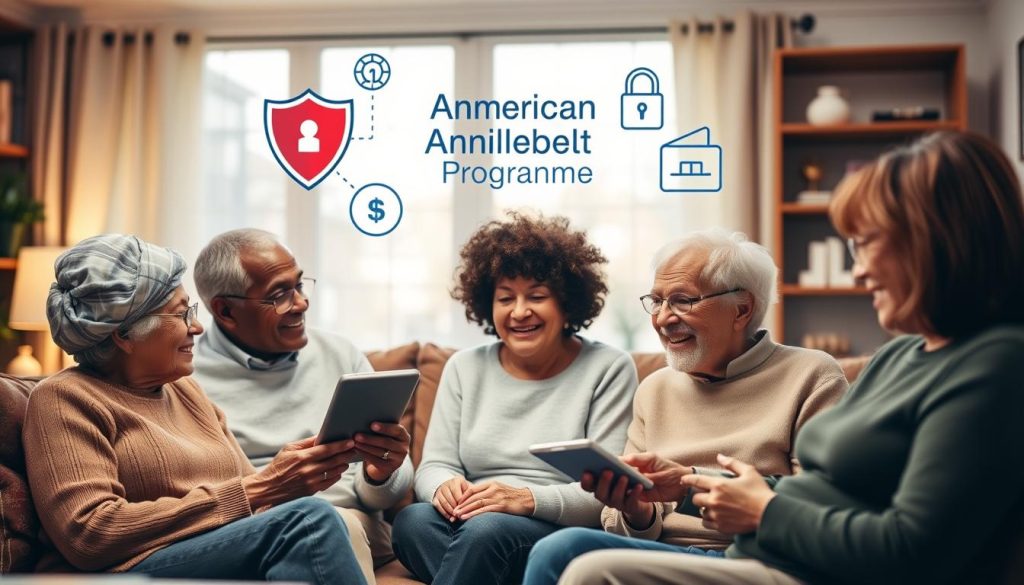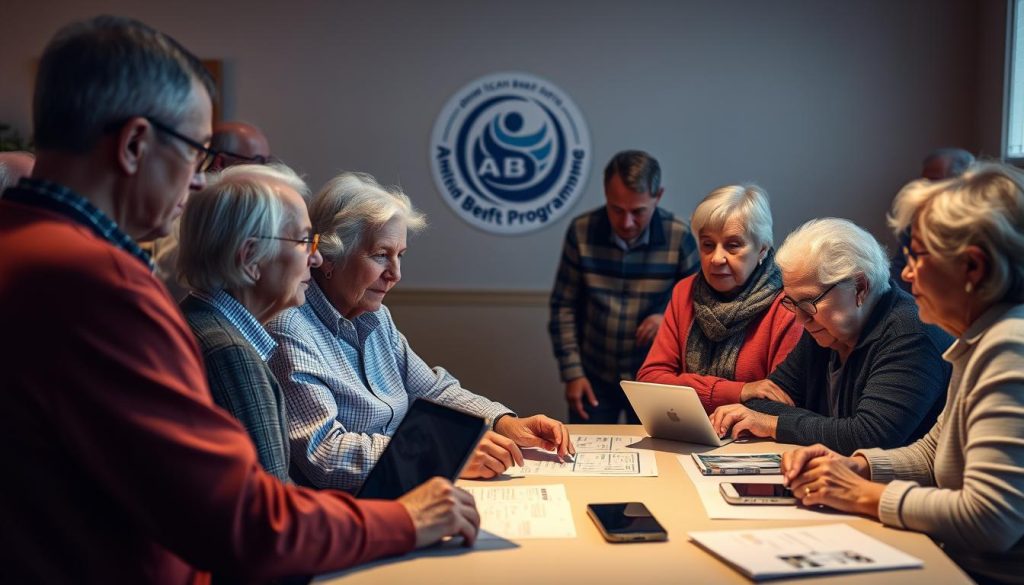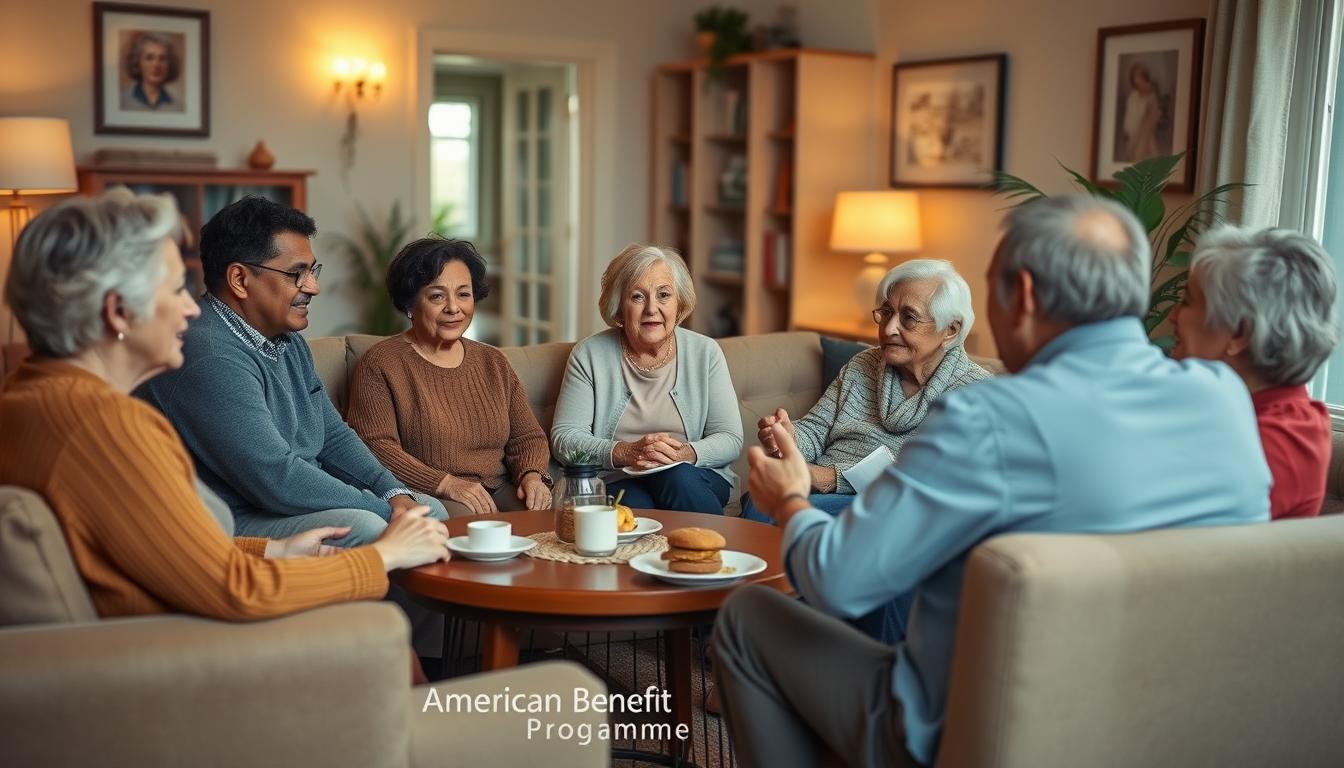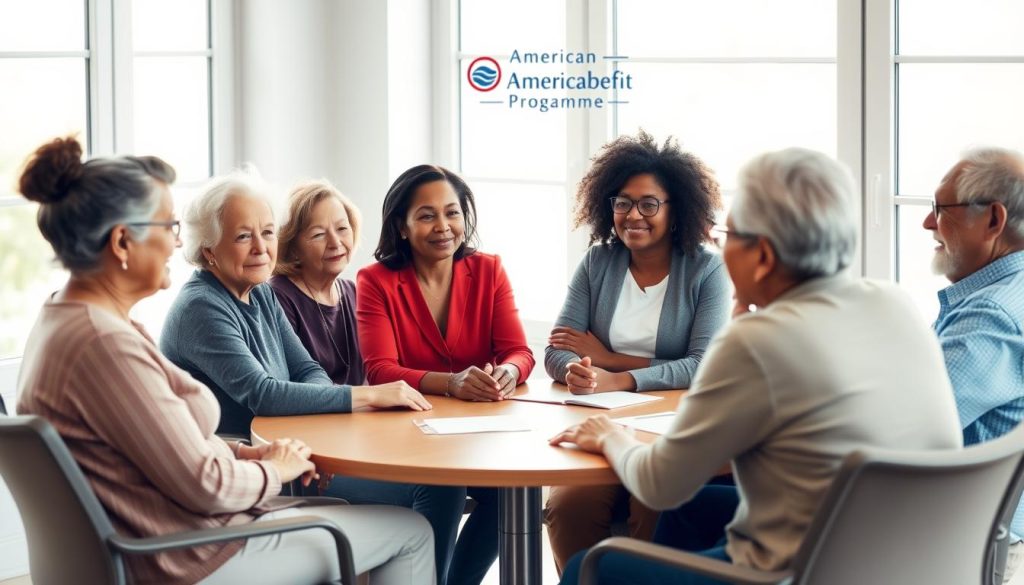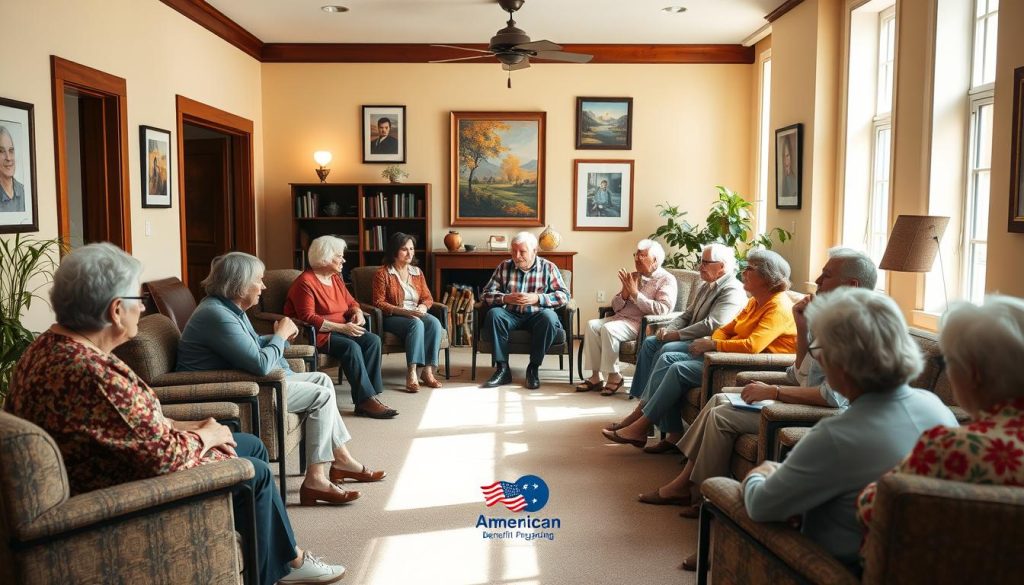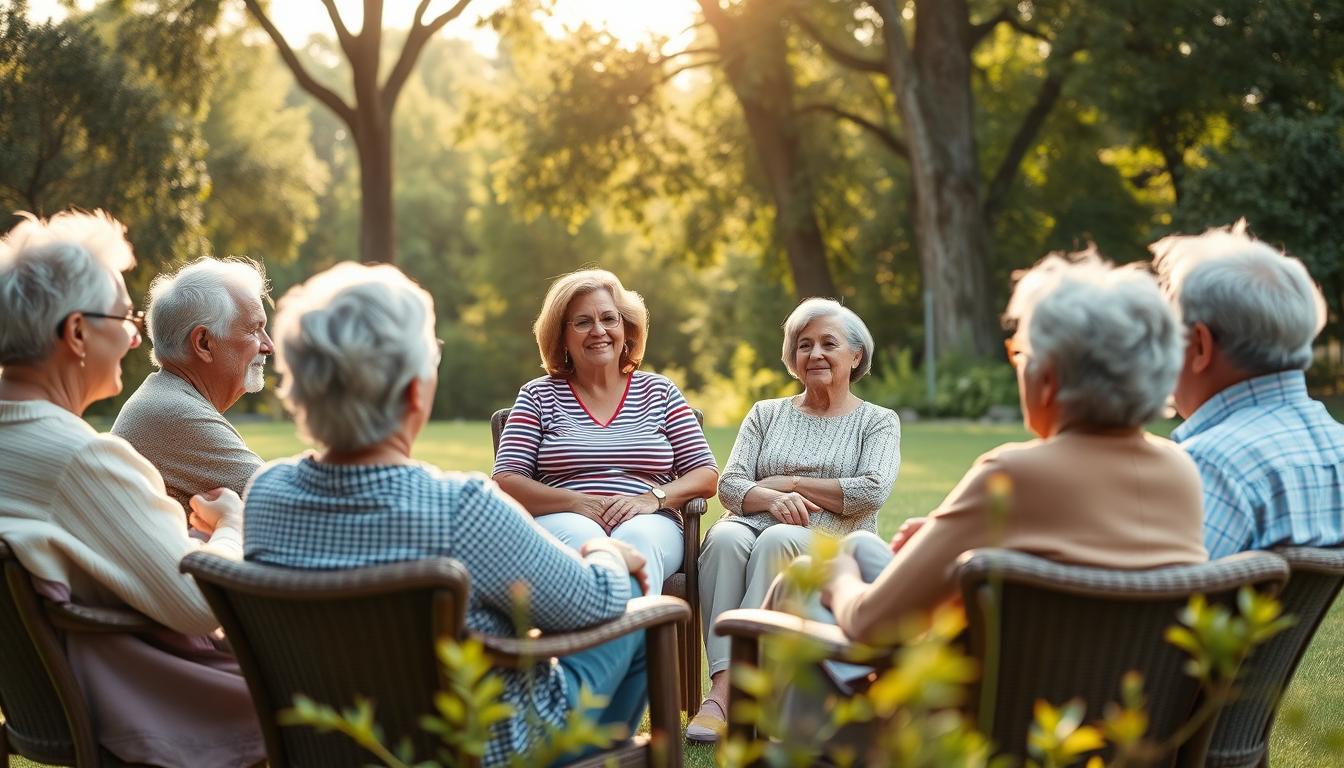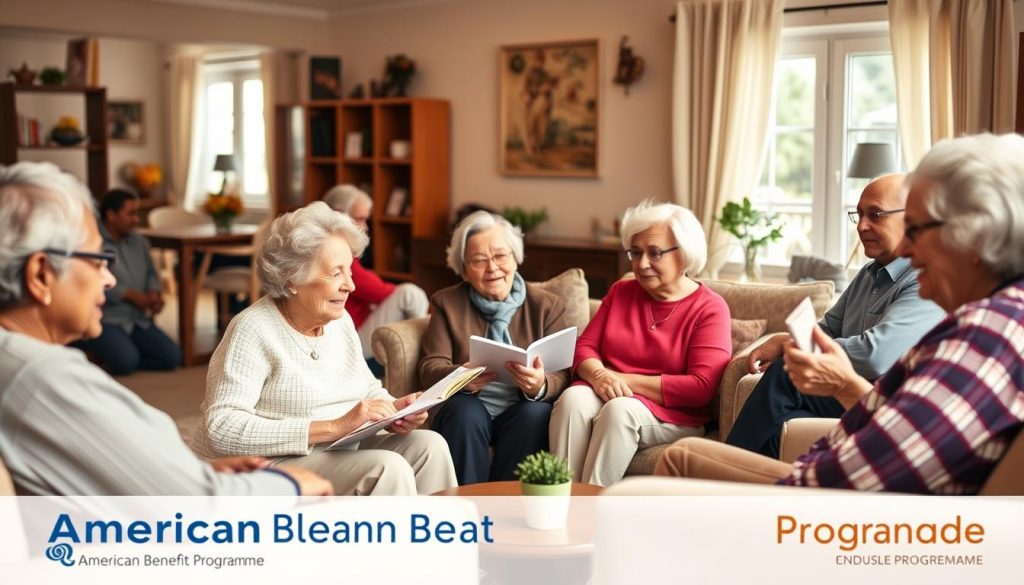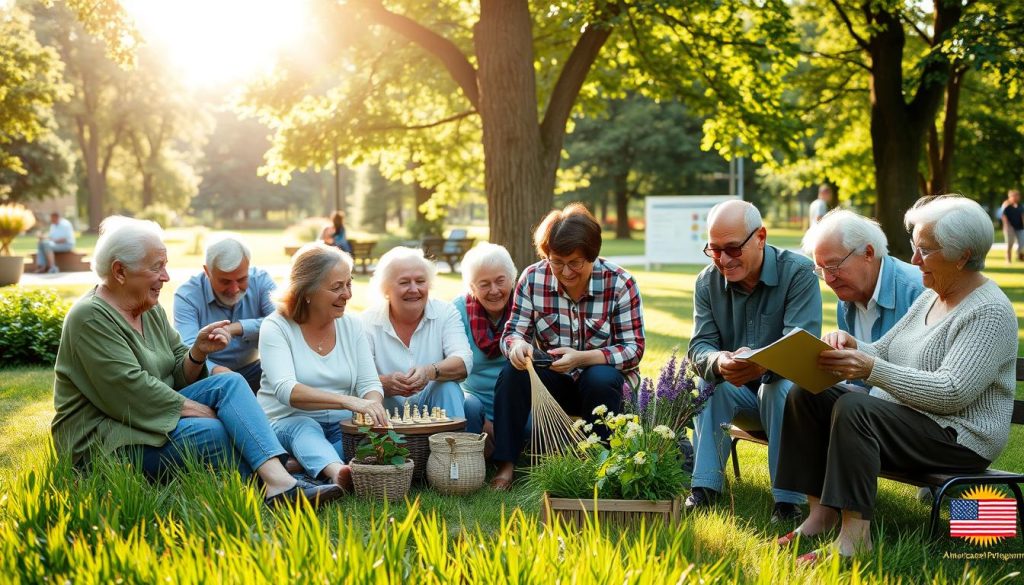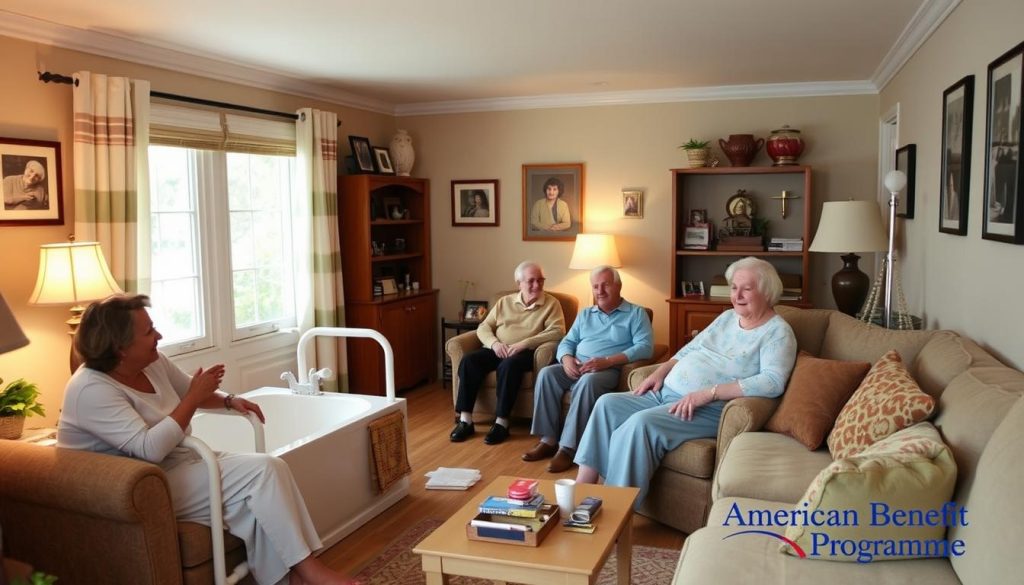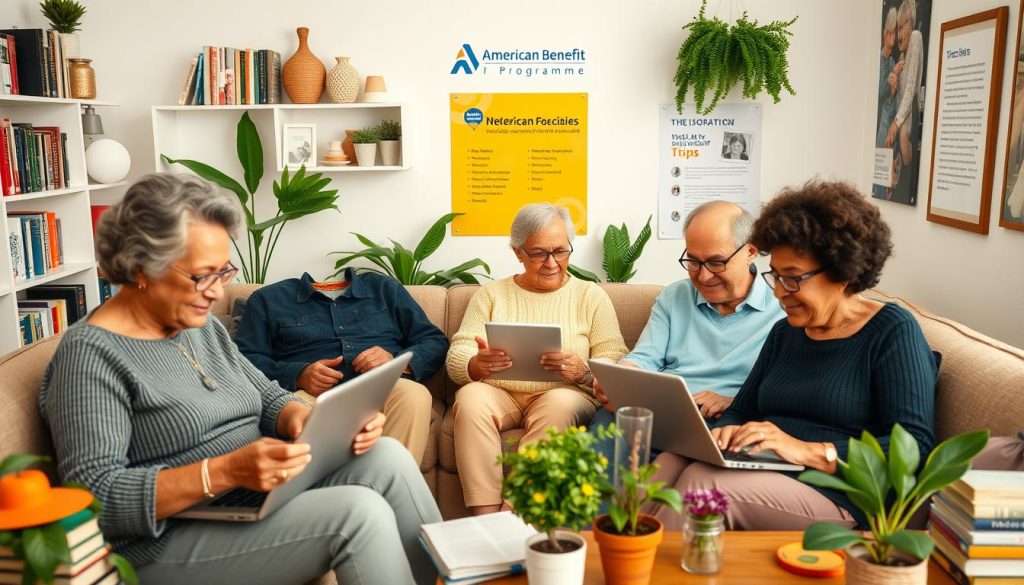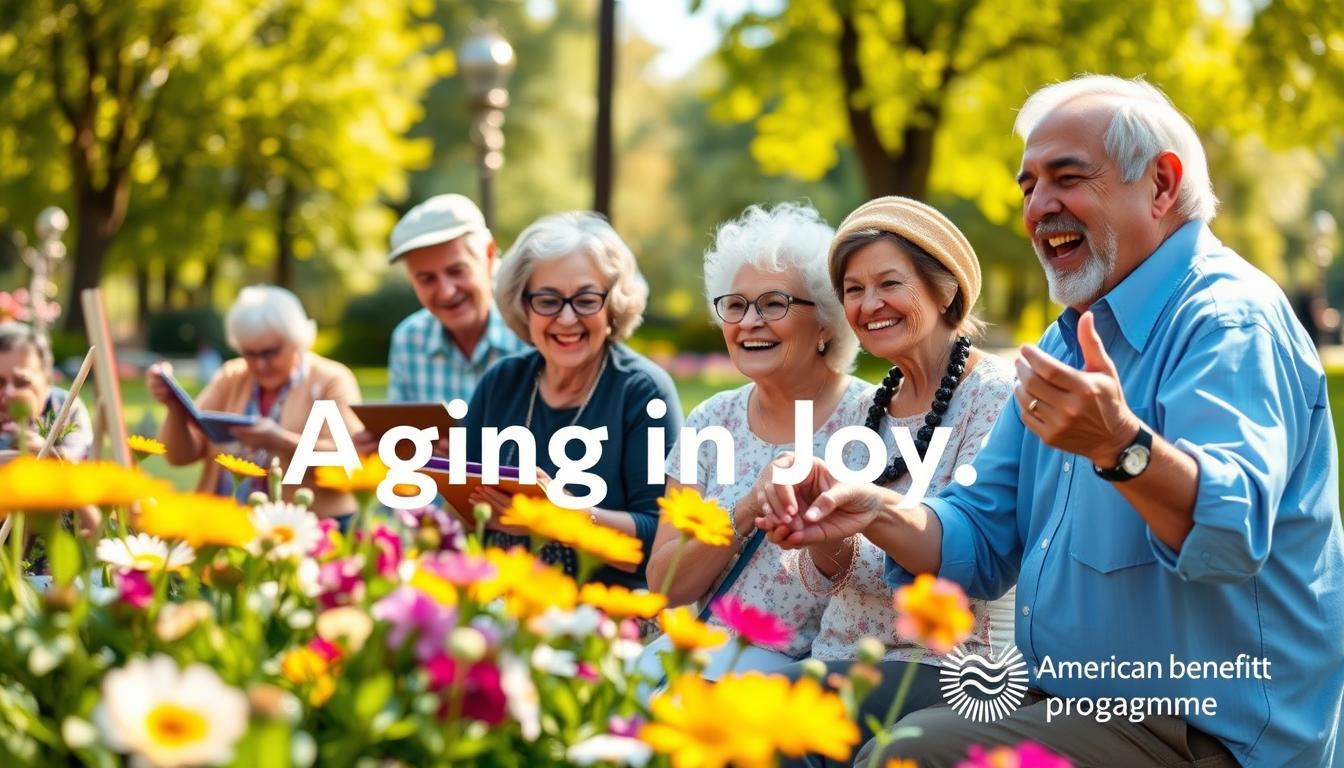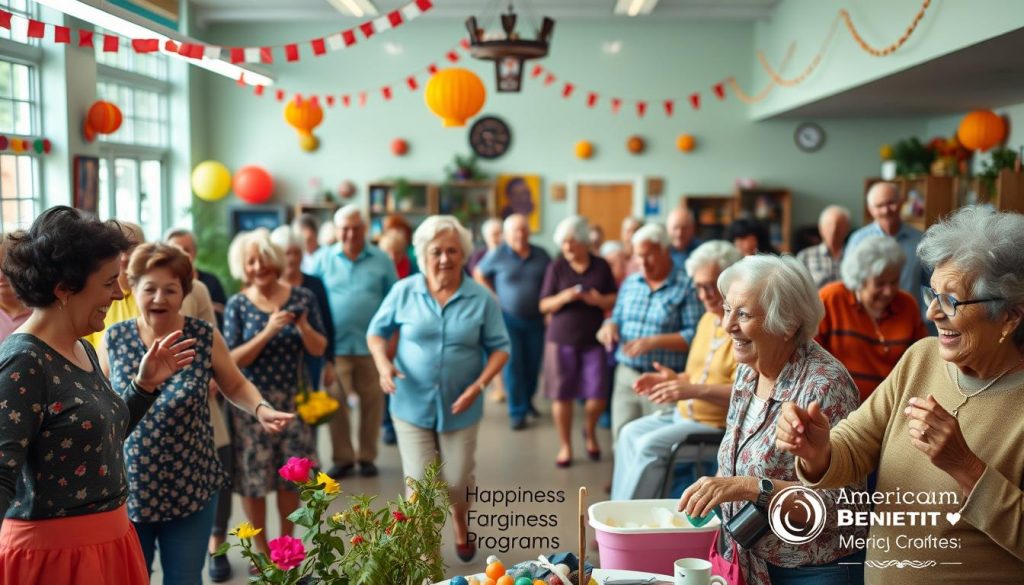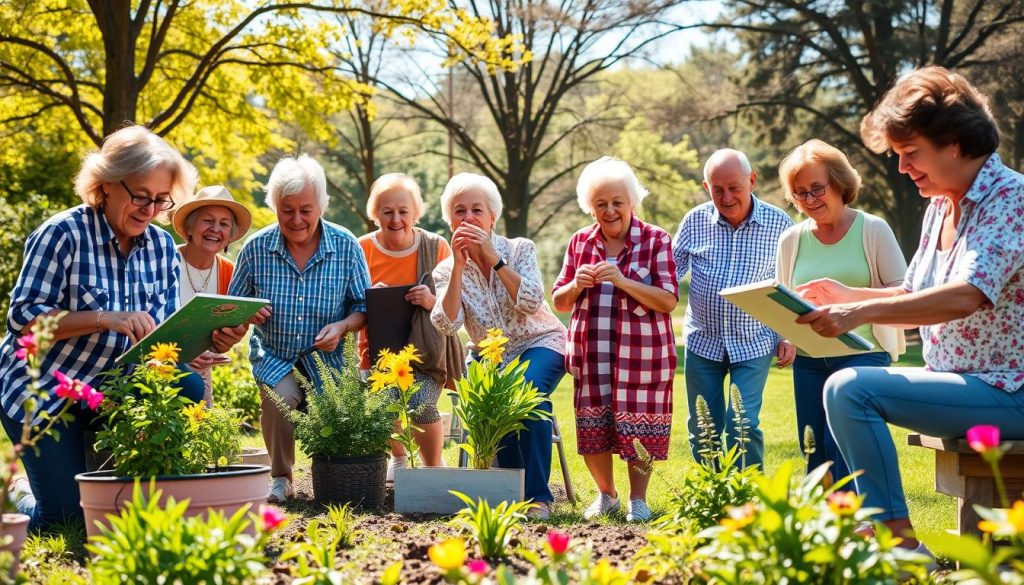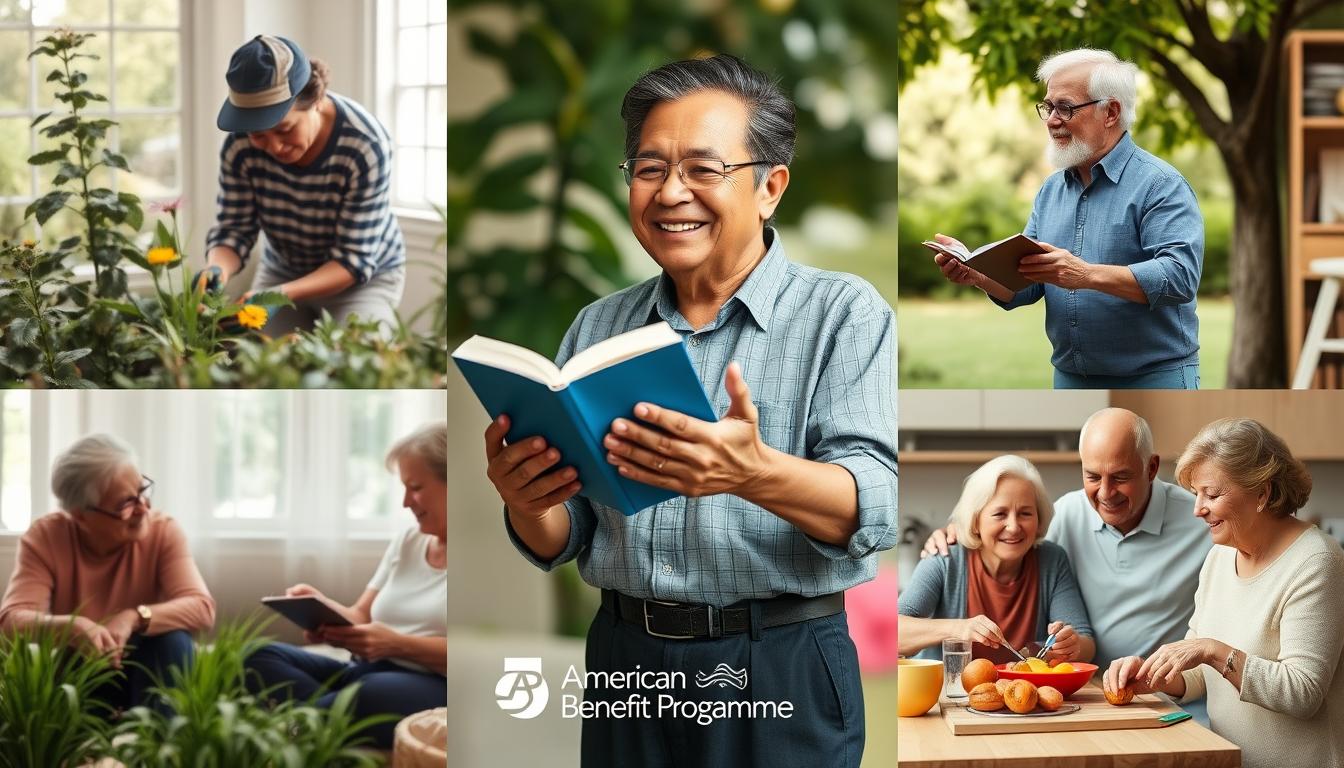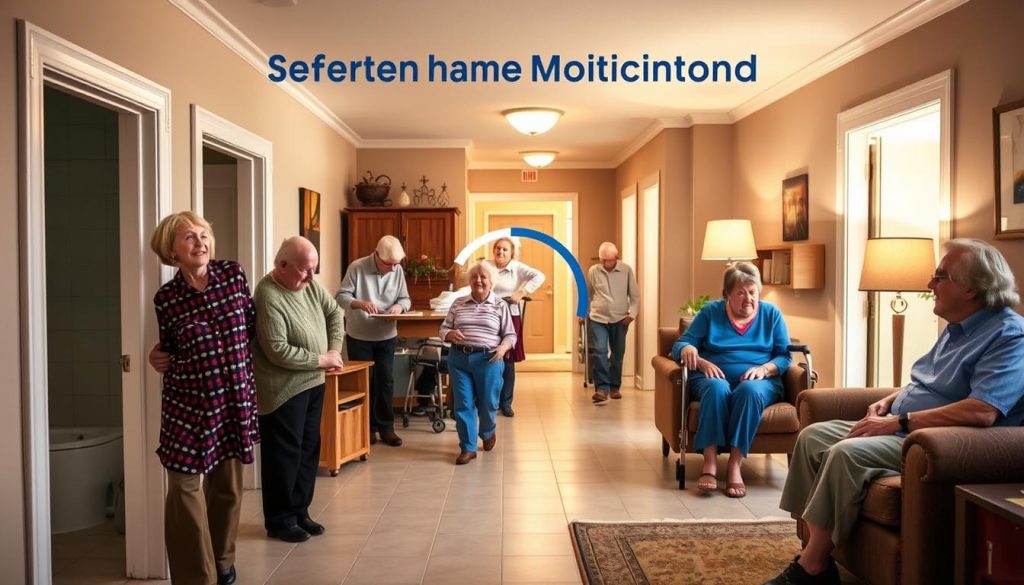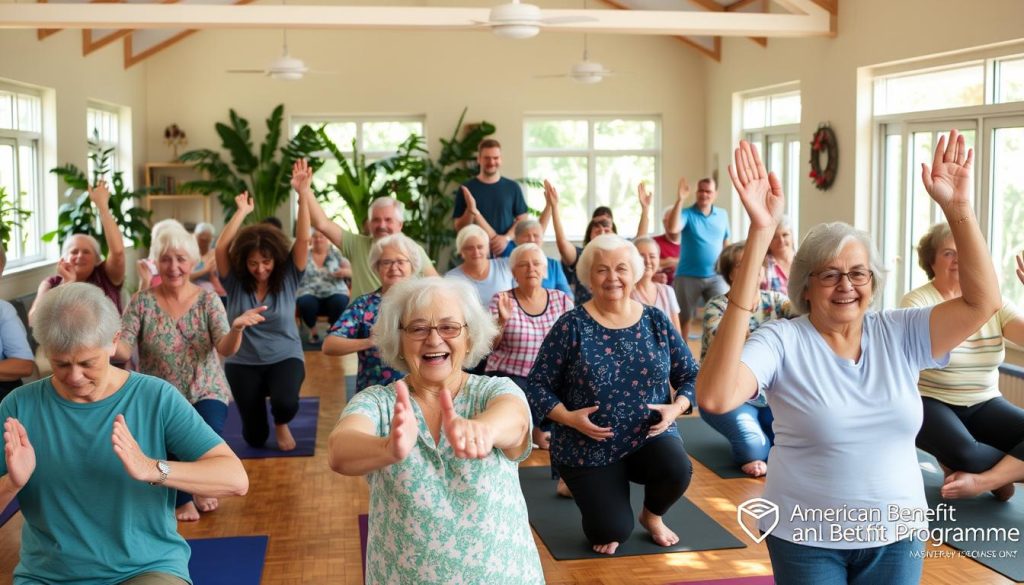Have you ever thought about what aging in peace means for seniors? And how special programs improve their lives? Currently, 17% of people in Canada are seniors. They also account for 47% of all healthcare costs1. It’s important to know how these programs help. They let seniors stay independent and respected during their later years. Plus, they bring seniors together through fun wellness activities.
Aging in peace programs are key to making seniors’ lives better. These programs offer care and events that keep them healthy. They also help with big issues seniors face. For example, falls cause 85% of seniors’ hospital visits each year1. Many seniors also have trouble managing their medicines2. These programs aim to make seniors safe and active in their communities.
Key Takeaways
- Aging in peace programs prioritize seniors’ well-being and dignity.
- Empowering older adults through community engagement is vital.
- Addressing healthcare challenges is essential for promoting peace.
- Healthy aging events foster social connections and activities.
- Effective support services are crucial for seniors managing multiple medications.
Understanding the Concept of Aging in Peace
Aging in peace means helping older people live happily where they are. It’s like aging in place but adds in getting help from elder care services. About 1 in 7 Americans over 65 live in senior homes3. This shows more people need help to stay in communities they love, not away from them.
How we see aging affects how we feel about getting older. A study showed 60% of seniors in communities feel they have a better life3. So, breaking down the walls of ageism and fostering friendships is vital. Laws like the Decade of Healthy Aging push for policies that support aging at home.
Also, the National Institute on Aging found over 40% of those 65 and older need long-term care3. So, programs must offer the right kind of help. Many initiatives focus on seniors in danger of homelessness or those with health issues. They make sure these folks get the full support they need day-to-day4.
Importance of Aging in Peace Programs
Aging in peace programs are very important today. More than 90% of older people want to stay in their homes as they age5. These programs help them do just that. They give needed support to older adults. They also make caring for the elderly less costly. Care homes are pretty expensive because they charge for staying there and medical care6. But, aging in peace programs let people stay at home. This saves money and helps them live with dignity6.
It’s key that older people can live safely on their own7. These programs can pay for home changes like grab bars or ramps7. This way, families can help care for their loved ones better. It brings families closer and gives them comfort6.
These programs create care plans that fit each person’s needs6. They offer breaks for caregivers to stop them from getting too tired. This keeps both the caregivers and the seniors happy and healthy6. In the end, aging in peace programs are great. They help older people feel valued and free. They also support families and save money compared to typical elder care6.
Key Components of Aging in Peace Programs
Aging in peace programs aim to make life better for older adults. They focus on things like community help, support networks, and being easy to get to. There are more than 55 million people in the U.S. who are 65 or older. This shows a big need for these programs for a lot of people8. Joining in with the community plays a big part. This is because almost 75% of Americans will need help from others to grow old in their own places8.
Different groups work together to make sure the care services cover everything older people need. This includes doctors, family, and government bodies. By working together, they make sure that the care can change as needed. States like Pennsylvania are asking older adults what they think. This is part of a bigger move to include them in making plans for their care9.
It’s important to make plans that fit the different needs of older people. Helping caregivers more and making things easy to use are key parts of these programs. These efforts make sure older adults can enjoy these helpful services9.
Senior Wellness Activities that Promote Peace
Many senior wellness activities help older adults feel more peaceful. These include being social and taking care of your mind. Doing things for yourself is good for your health and helps you stay independent10. Spending time with others, exercising, or getting involved in the community makes life better10.
Staying active is key for seniors, says the World Health Organization. They suggest mixing up workouts with aerobic, strength, and balance exercises11. Yoga, tai chi, and water aerobics are great for your body and mind12. Gardening can also make you feel mentally better and connect you with others11.
Eating well and sleeping enough are very important for seniors10. Learning about food and cooking can make you feel great. Keeping your brain busy with books or puzzles is also good for your mind11. Joining clubs, volunteering, or going to events helps you not feel lonely and adds joy to life12.
Aging in Peace Programs: Resources and Support
Aging in peace programs help seniors have a better quality of life. There are many resources to support these efforts. Nonprofits like SPOP in New York offer healthcare for those 55 and older. They focus on mental health because about 20% of older adults struggle with it. This can be due to being sick, alone, or losing someone13.
Getting transportation is key for seniors to reach these services. There are also programs for meals and counseling. For example, SPOP provides therapy in many languages. This helps more people13.
Community support is important for these programs to work. Funds from different places help improve senior services. A big part of the money goes to keeping seniors healthy14. This includes rides to healthcare and meals. It helps seniors feel connected to others.
| Resource Type | Description | Programs Offered |
|---|---|---|
| Nonprofits | Organizations focused on mental health and elder care | SPOP, Community Counseling |
| Governmental Support | Grants and funding for senior initiatives | Health Promotion, Disease Prevention |
| Transportation Services | Assistance to access medical and social services | Transport to appointments, Community Hubs |
| Meal Delivery | Nutritional support for seniors at home | Home-delivered meals |
| Counseling Programs | Support for mental well-being and grief | Bereavement Groups, Therapy Sessions |
With these resources and community efforts, we can create better places for seniors. This makes aging in peace programs successful.
Mindfulness for Seniors: A Pathway to Peace
Mindfulness helps seniors feel better and find peace as they age. They can handle stress better and feel stronger inside. Adding mindfulness to their daily life fits well with programs for aging peacefully.
The Benefits of Mindfulness in Older Age
Mindfulness really helps improve seniors’ lives. There’s more and more focus on using mindfulness to help with chronic illnesses and overall happiness as people get older15. Meditating regularly makes positive changes in the brain. These are good for keeping the mind sharp and emotions steady15. Yoga and Tai Chi are good for the body and the heart15. People doing mindfulness programs feel less anxious and more at peace afterward16.
Mindful Activities for Seniors
Different activities, like Tai Chi, dance, and meditation, are great for seniors’ body and mind health15. Meditation, for example, helps with stress and pain and can make thinking clearer15. These activities help seniors find joy and peace again16. They also help with feeling lonely or sad, giving seniors ways to handle their emotions better17.
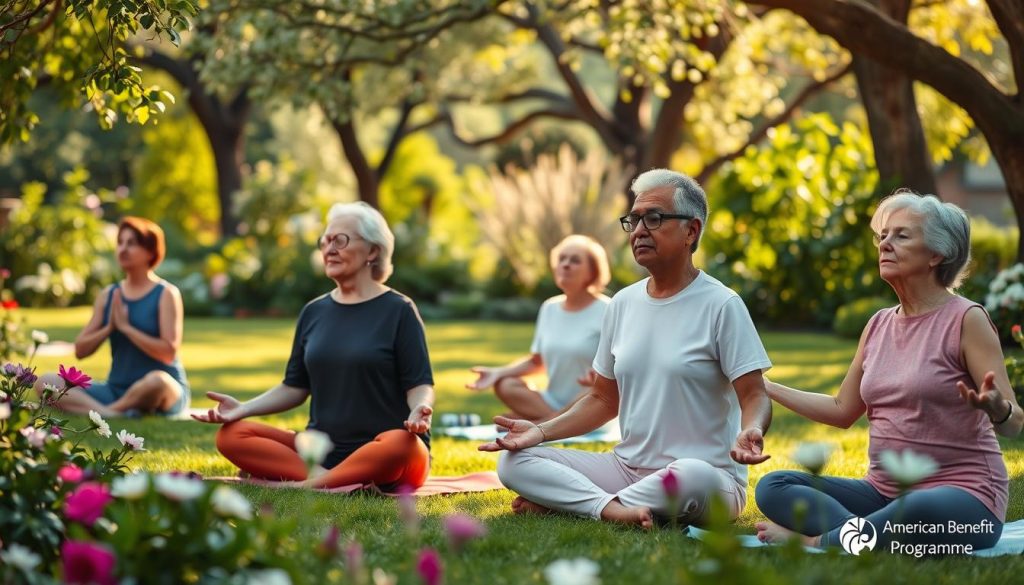
| Mindful Activity | Benefits |
|---|---|
| Meditation | Stress reduction, emotional healing, improved cognitive function |
| Yoga | Physical strength, flexibility, mental clarity |
| Tai Chi | Improved balance, reduced anxiety, chronic pain management |
| Mindful Walking | Enhances mindfulness skills, allows for reflection |
| Group Discussions | Social connection, reduced feelings of isolation |
Adding these fun practices to their day helps seniors be healthier in body and mind. They find more joy and peace as they age17.
Healthy Aging Events That Inspire Community Engagement
Healthy aging events are key to getting seniors involved in their community. Events like health fairs and seminars teach important health tips. They help seniors take good care of themselves. Studies show that active seniors can avoid heart problems. This tells us how vital these social and educational gatherings are18.
By hosting these events, communities give out important health info. These activities help seniors make friends, which is really good for their health. A study from Harvard even says friendships are more important than how much money you make. With more seniors around, it’s important to have events just for them1819.
Great aging in peace programs need everyone to help, especially the seniors. They can do art, crafts, or fitness classes. These fun activities stop seniors from feeling lonely. All Seniors Care is one group doing this right. They have five different activities every day for seniors18.
The Grateful Aging Program (GAP) shows how to get seniors more involved. GAP teaches about aging well and making it meaningful. It helps seniors feel important and connected. These events are essential for a happy, healthy community life19.
| Event Type | Description | Benefits |
|---|---|---|
| Health Fairs | Offer screenings, health education, and lifestyle resources. | Increased access to health information and services. |
| Educational Seminars | Focus on topics such as nutrition, exercise, and mental health. | Empower seniors with knowledge for better health choices. |
| Social Gatherings | Provide a space for seniors to connect and build relationships. | Reduce isolation and enhance emotional well-being. |
Retirement Community Programs Fostering Peaceful Living
Retirement places help make life peaceful for seniors. They mix many methods to boost well-being and friendships. Safety, happiness, and being together are big deals here20. Think handrails, floors that prevent slips, and help buttons. These ensure quick help and lower injury risks20.
Having fun activities helps seniors feel happy. Feeling safe lets them do more on their own and join in events. This is good for their hearts20. Places to meet and do things together create a warm community. This builds deep friendships which are key for a happy mind20. Classes like Little Rebels Music help everyone make friends. These classes bring joy and smartness to everyone who joins21.
Haltom City, Texas, has retirement places with many home types. They fit all ways of life and money plans. There are gyms, pools, and health food programs22. Checking health often and wellness activities keep residents healthy. They bring peace and calm every day22.
Challenges Facing Aging in Peace Programs
Aging in peace programs face many hurdles. The world’s elderly population is rising quickly. Soon, one in six people will be over 65 years old. This increase means we need more and better elder care services23. Challenges like money problems, how people view aging, and getting to services can stop people from joining in.
Addressing Common Barriers to Participation
Many elderlies can’t take part in these programs because of various reasons. They might not know about the help available. Physical problems or not having enough money can also stop them. Plus, some feel ashamed because they need help as they get older.
- Lack of awareness of available elder care services.
- Physical limitations that hinder access to programs.
- Financial constraints limiting participation.
- Social stigma associated with aging and dependency.
Research shows that getting the community involved helps. It makes more people aware of these services24.
Solutions for Effective Program Implementation
To get more people involved, we need new ideas. Here are some:
- Checking homes and making them better so older people can stay there safely, like what Habitat Wisconsin River Area does24.
- Working with local groups to offer what the elderly need.
- Starting clubs and activities to help them make friends. Japan’s Min-Iren does something similar25.
- Creating strong plans for getting and using money to keep services going.
We need lots of different plans to make sure these programs can help our growing number of elderly people.
Aging Gracefully Workshops: Skills for Peaceful Living
Aging workshops are great for seniors. They learn how to live happily and in peace. Topics like health, stress, food, and staying active are covered. It is all about living well.
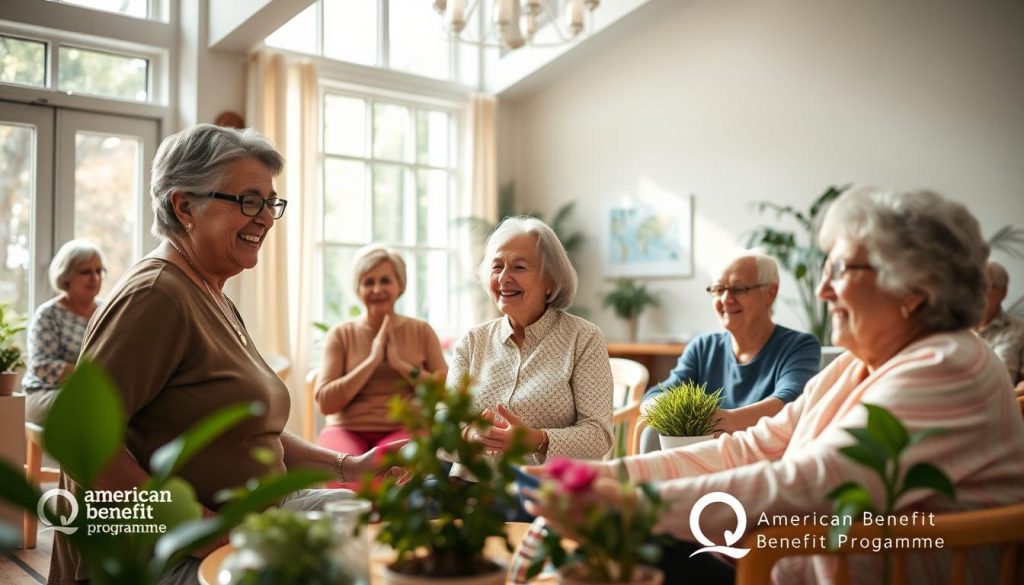
These workshops make life better. They teach how to handle hard times and stay happy. Seniors learn to take care of themselves, which helps them enjoy life more26.
Staying active is key to being healthy. Doing things together and eating well helps a lot. Workshops teach how to keep the mind sharp too27.
Having friends is important. It helps fight loneliness. Sharing life with others makes people happy. They learn new things and feel good about their experiences27.
In the end, aging workshops help seniors live joyfully. They learn useful things. And they get to live their lives fully and with joy.
Evaluating the Effectiveness of Aging in Peace Programs
It is key to assess aging in peace programs. This shows their impact on happiness and personal stories. They check happiness levels and health benefits. Such programs need clear facts on emotional health and social bonds. Studies show these programs help older people live better28. They also find a big need for programs based on solid facts. These help improve care services for the elderly28.
Looking at how involved communities are can give us good clues. For example, events about healthy aging bring more people together. This means more community action. Studies still prefer meeting people in person for these programs. Yet, the benefits of using technology are not to be missed28. Programs named MATTER OF BALANCE and CHRONIC DISEASE SELF MANAGEMENT share success. They cut down on hospital visits and up activity for older folks29.
Recent work underlines the need for clear and detailed evaluations. They looked at 601 articles but only found 50 studies fitting. This makes us question what proof exists for these programs28. Also, promoting healthy aging helps older and younger people connect well. This makes the programs work better30.
| Evaluation Criteria | Metrics | Expected Outcomes |
|---|---|---|
| Participant Satisfaction | Surveys, Feedback Forms | Increased Engagement, Positive Experiences |
| Health Outcomes | Health Assessments, Medical Records | Reduction in Health Care Utilization |
| Community Engagement | Event Attendance, Volunteer Participation | Enhanced Social Connectivity |
| Quality of Life Indicators | Self-Determination, Emotional Well-Being | Improved Overall Well-Being |
To make aging in peace programs keep getting better, good checks are a must. They must see if these programs meet older people’s needs. By listening and using what works, we can help aging people do well.
Conclusion
Exploring aging in peace programs shows their key role in helping older adults. These programs make life better for them, touching on health and happiness. By welcoming everyone, older people feel part of their community, fighting loneliness.
It’s important to meet the changing needs of older people. Aging in peace programs must know what each person needs. They must also make it easy to get to services. Many older adults want to stay in their neighborhoods. So, we need to make sure they can31.
Aging in peace efforts are a job for us all. It helps seniors and everyone else too. With focus on these programs, we make sure older people enjoy their later years. This matches goals for a better world found here focused on peacebuilding and development. It makes a society where aging is a joy32.
Source Links
- Technology to support aging in place: key messages for policymakers and funders
- Navigating Support Services for Aging Parents: A Comprehensive Guide to Local Resources | Briggs Home Care
- Finding Peace of Mind: How Senior Living Can Improve Your Family’s Life
- PEACE Program | Programs and initiatives
- Advocacy, peace of mind and reassurance for aging at home | Senior Choice at Home
- 4 Key Benefits of Aging in Place
- The Best Aging in Place Resources – At Peace Health
- Aging Our Way, PA | Department of Aging
- 10 Self-Care Activities for Seniors for Health and Happiness
- Activities for the Elderly
- Senior Wellness Activities | WhiteStone
- Programs and Services – SPOP
- How to Apply Grants for Seniors Programs? – At Peace Health
- Mind-Body Connection: The Integration of Meditation and Physical Activity for Seniors – Total Life
- Embracing Mindfulness: Ellen’s Journey to Inner Peace with UR Community Cares – UR Community Cares
- Mindfulness for Seniors by Jon Shore
- 5 Ways Seniors Can Increase Community Engagement – All Seniors Care
- The Grateful Aging Program: A Naturalistic Model of Transformation and Healing into the Second Half of Life
- TERRABELLA WINDSOR LAKE
- Intergenerational Programs Benefit Both Youth & Seniors
- Discovering Inner Peace and Healthy Aging in Your Retirement Community in Haltom City, TX
- Ageing | United Nations
- Aging in place with peace of mind
- Finding Peace: Aging, Solidarity, and Min-Iren
- Essential Self-Help Strategies for Elderly Well-being – At Peace Health
- Aging Well – HelpGuide.org
- Frontiers | A Systematic Review of the Effectiveness of Intergenerational Programs
- Monroe County, NY – Office for the Aging
- Healthy Aging
- Community Supports for Rural Aging in Place and Independent Living Overview – Rural Health Information Hub
- Active aging needs from the perspectives of older adults and geriatric experts: a qualitative study
